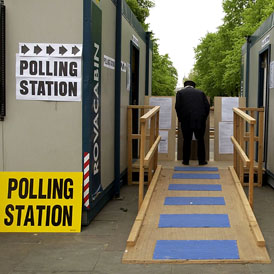Alternative Vote: Your questions answered
As the Electoral Commission sends out almost 28 million information leaflets to improve public awareness about the 5 May referendum, Channel 4 News presents a Q and A on AV.

Why are we having a referendum?
As one of their pre-conditions for entering a Coalition Government with the Conservatives, the Liberal Democrats insisted on at least a referendum on electoral reform. They argue that two-thirds of MPs returned under the existing First Past the Post (FPTP) system at the last election failed to achieve a majority of the vote in their constituency – therefore Britain is not fully democratic.
Why the Alternative Vote (AV)?
The Conservatives – who oppose electoral reform – agreed as a compromise to a full proportional representation system that they would back a referendum on AV – though they’ll still call for a no vote.
So AV is not Proportional Representation (PR)?
No. Full PR – in which parties are given the number of seats in Parliament proportionate to the number of votes they receive across the country – would have meant breaking away from Britain’s traditional constituency system. AV means that voters will still vote in constituencies, but the results will not be fully proportional.
So what is AV?
It is what’s called a preferential system, because voters list the candidates in their order of preference.
And then what happens?
Under FPTP – where voters put an X against the candidate they want to vote for – the winner is the candidate who has the most votes, even if he or she has more total votes cast against (let’s say her for simplicity) than in her favour. But under AV, voters list the candidates in order of preference – 1 against their first choice, 2 against their next and so on. The winner is not necessarily the candidate with the most first preference votes (ie 1s against her name). If that total is less than 50 per cent of the total number of votes cast, there is a second round of counting.
In this second round, the candidate with the fewest first preferences is eliminated and those voters who supported her have their second preferences added to the totals for the other candidates. This continues until one candidate has more than 50 per cent of the votes cast in that round.
So those people who support the least popular candidate have more votes than those who support the most popular?
No. Everyone who votes has one vote counted in each round of voting. It’s just that those who support the most popular candidates continue to vote for the same candidate in each round – as presumably they would wish to do. Those who vote for a less-popular candidate have to accept that that candidate cannot get enough support to win and therefore have the chance to express a preference between those candidates who remain in the race.
Am I allowed to vote for just one candidate?
Yes. But if that candidate is eliminated you will not have a vote in future rounds. This has prompted opponents of AV to point out that the reform will not achieve supporters’ aim of having a winning candidate achieve more than 50 per cent of total votes – though she will have more than 50 per cent of votes cast in the final round.

Will AV boost support for extremist parties?
In one way it may. At present, some voters are deterred from voting for extemist parties by the knowledge that they are unlikely to be elected, so they will cast their vote for one of the more mainstream parties instead. Under AV they have nothing to lose by giving – say – the BNP their first preference vote because, if that candidate is eliminated, they will have their second – and potentially third, fourth and fifth – preferences counted in future rounds.
So the BNP will support AV?
No, because it won’t help them win seats. Only a PR system would give them seats in proportion to the share of vote they achieve. Under AV, they may get more first preference votes than they would under FPTP, but in most cases it would still not be enough to get them through to later rounds of counting. Indeed, in a very divided constituency, they arguably have a better chance of winning a seat under FPTP. One effect of AV might, however, be to increase their credibility and therefore strengthen their arguments for a move to full PR.
Would AV result in more hung parliaments?
Not necessarily. Of course, last year’s election under FPTP resulted in a hung parliament – a symptom of a divided electorate, rather than a result of the system. Having said that, it’s been calculated that, if the 2010 General Election had been fought under AV, both the Conservatives and Labour would have won fewer seats and the Lib Dems about 30 more. This would have meant they could have formed a coalition with Labour – instead of the Conservatives – as the two parties would have had enough seats to form a majority in the Commons. The political realities of a defeated Labour Government would still, however, have been likely to drive the Lib Dems towards the Conservative Party.
Isn’t it all just a waste of time and money?
That is for the voters to decide. This is only the second referendum in British history. Do we care enough to go out and vote? Can the rival camps mount sufficiently exciting campaigns to lure us to the polling station in the first place? The answers to these questions can only begin to be determined after 5 May.